Social Inclusion Club through Music Skills Project: Detailed Report
VerifiedAdded on 2021/06/17
|22
|6579
|383
Report
AI Summary
This report presents a comprehensive analysis of the Social Inclusion Club through Music Skills (ISCS) project, focusing on its development, objectives, and potential impact on social inclusion. The project aims to create a platform for social interaction and skill development for children aged 12-17, including those with disabilities, through music training. The report details the project's benefits, including enhanced social skills, interpersonal relationships, and overcoming stereotypes, while also exploring potential partnerships, resource requirements, and sustainability plans. The ISCS project targets the community by providing music lessons and creating inclusive activities that are meaningful for interaction while raising community awareness. The report further discusses the characteristics of social inclusion, the target group, and the project's objectives, highlighting the importance of music as a tool for social cohesion and personal expression, contributing to the UN Sustainable Development Goals. The report also includes a project summary, funding sources, and a conclusion, emphasizing the project's role in promoting social participation, integration, and personal development. The report also details the characteristics of social inclusion, the target group, and the project's objectives.
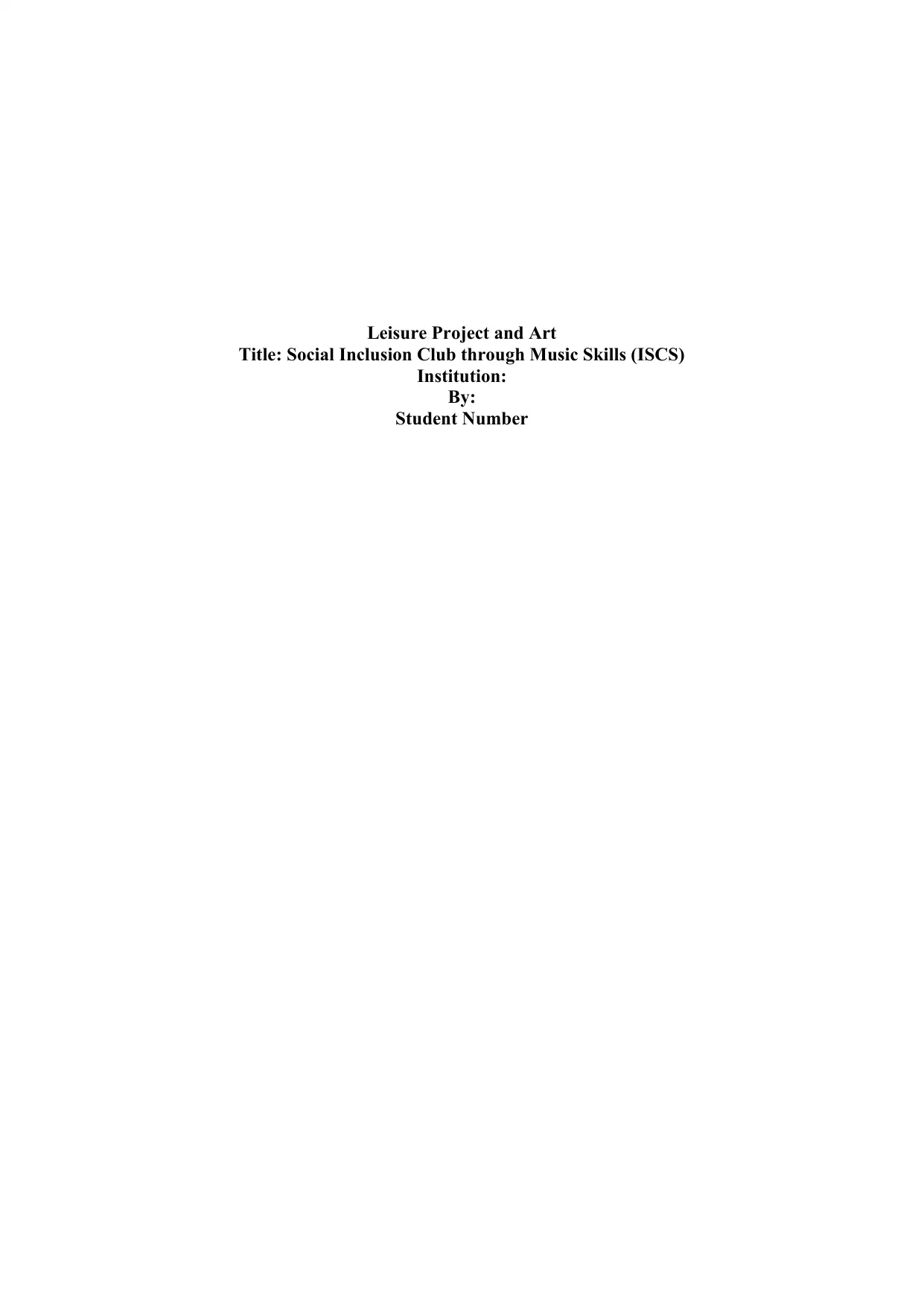
Leisure Project and Art
Title: Social Inclusion Club through Music Skills (ISCS)
Institution:
By:
Student Number
Title: Social Inclusion Club through Music Skills (ISCS)
Institution:
By:
Student Number
Paraphrase This Document
Need a fresh take? Get an instant paraphrase of this document with our AI Paraphraser
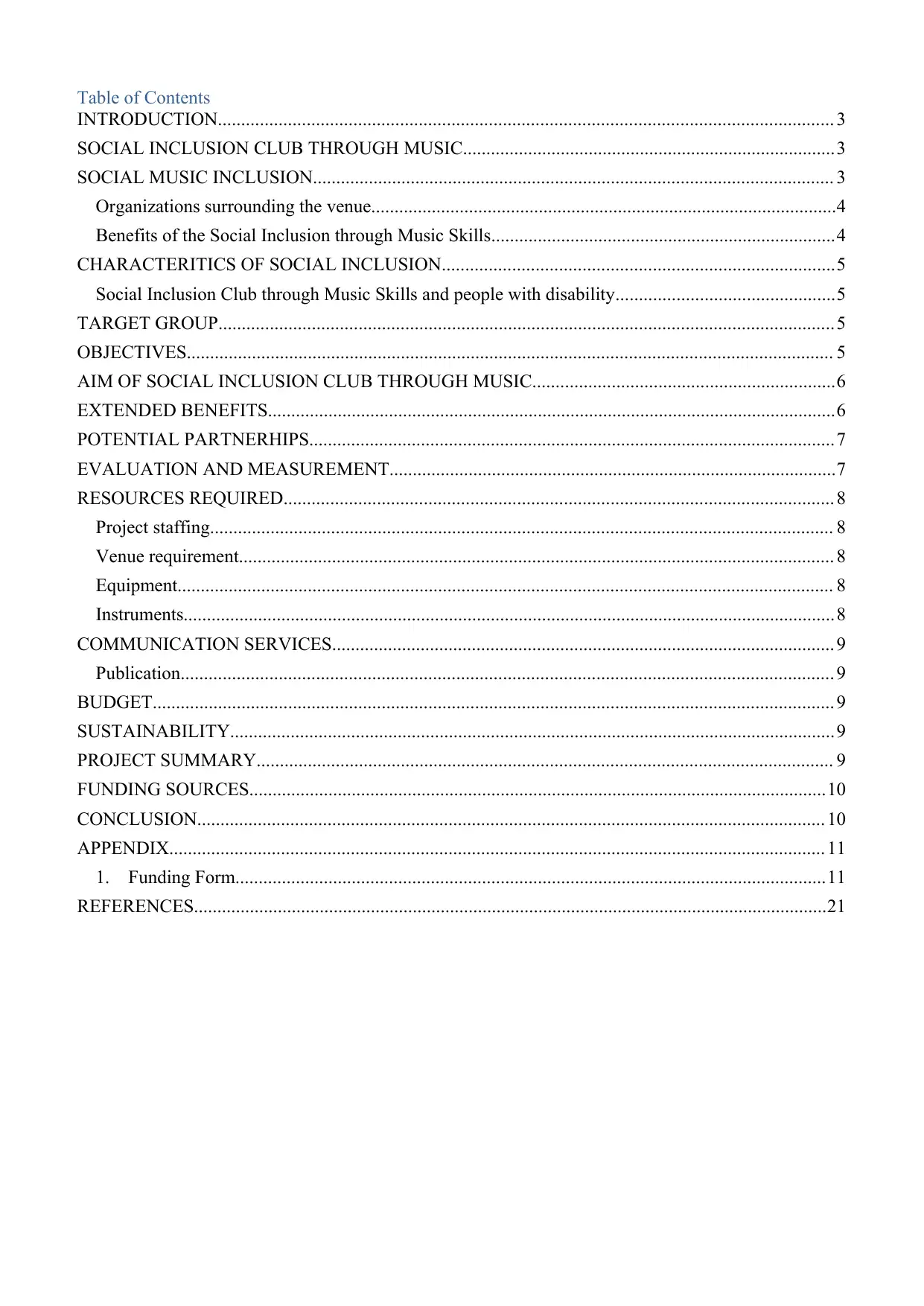
Table of Contents
INTRODUCTION.................................................................................................................................... 3
SOCIAL INCLUSION CLUB THROUGH MUSIC................................................................................3
SOCIAL MUSIC INCLUSION................................................................................................................ 3
Organizations surrounding the venue....................................................................................................4
Benefits of the Social Inclusion through Music Skills..........................................................................4
CHARACTERITICS OF SOCIAL INCLUSION....................................................................................5
Social Inclusion Club through Music Skills and people with disability...............................................5
TARGET GROUP....................................................................................................................................5
OBJECTIVES........................................................................................................................................... 5
AIM OF SOCIAL INCLUSION CLUB THROUGH MUSIC.................................................................6
EXTENDED BENEFITS..........................................................................................................................6
POTENTIAL PARTNERHIPS.................................................................................................................7
EVALUATION AND MEASUREMENT................................................................................................7
RESOURCES REQUIRED...................................................................................................................... 8
Project staffing...................................................................................................................................... 8
Venue requirement................................................................................................................................ 8
Equipment............................................................................................................................................. 8
Instruments............................................................................................................................................8
COMMUNICATION SERVICES............................................................................................................ 9
Publication............................................................................................................................................ 9
BUDGET.................................................................................................................................................. 9
SUSTAINABILITY..................................................................................................................................9
PROJECT SUMMARY............................................................................................................................ 9
FUNDING SOURCES............................................................................................................................10
CONCLUSION....................................................................................................................................... 10
APPENDIX............................................................................................................................................. 11
1. Funding Form...............................................................................................................................11
REFERENCES........................................................................................................................................21
INTRODUCTION.................................................................................................................................... 3
SOCIAL INCLUSION CLUB THROUGH MUSIC................................................................................3
SOCIAL MUSIC INCLUSION................................................................................................................ 3
Organizations surrounding the venue....................................................................................................4
Benefits of the Social Inclusion through Music Skills..........................................................................4
CHARACTERITICS OF SOCIAL INCLUSION....................................................................................5
Social Inclusion Club through Music Skills and people with disability...............................................5
TARGET GROUP....................................................................................................................................5
OBJECTIVES........................................................................................................................................... 5
AIM OF SOCIAL INCLUSION CLUB THROUGH MUSIC.................................................................6
EXTENDED BENEFITS..........................................................................................................................6
POTENTIAL PARTNERHIPS.................................................................................................................7
EVALUATION AND MEASUREMENT................................................................................................7
RESOURCES REQUIRED...................................................................................................................... 8
Project staffing...................................................................................................................................... 8
Venue requirement................................................................................................................................ 8
Equipment............................................................................................................................................. 8
Instruments............................................................................................................................................8
COMMUNICATION SERVICES............................................................................................................ 9
Publication............................................................................................................................................ 9
BUDGET.................................................................................................................................................. 9
SUSTAINABILITY..................................................................................................................................9
PROJECT SUMMARY............................................................................................................................ 9
FUNDING SOURCES............................................................................................................................10
CONCLUSION....................................................................................................................................... 10
APPENDIX............................................................................................................................................. 11
1. Funding Form...............................................................................................................................11
REFERENCES........................................................................................................................................21
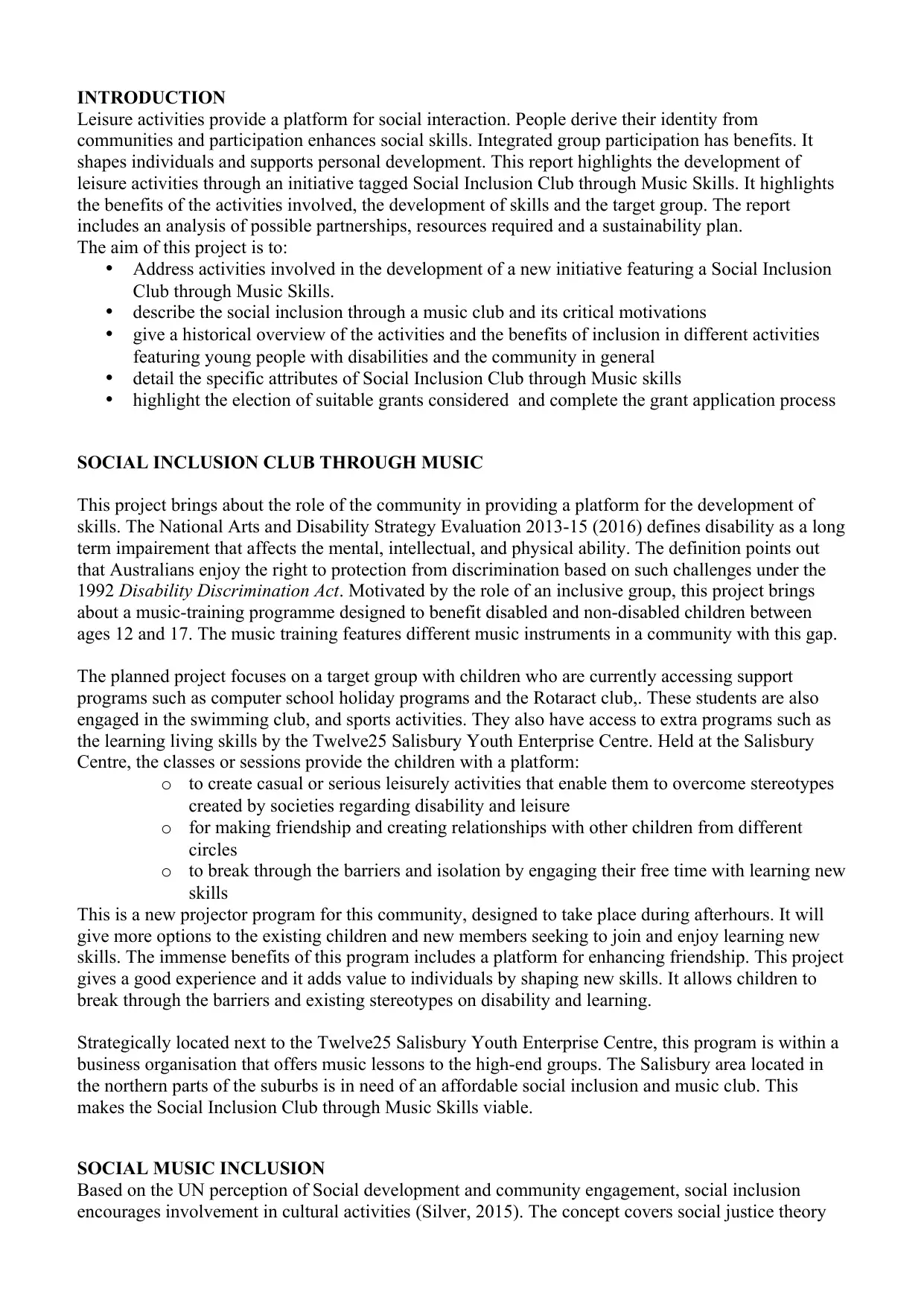
INTRODUCTION
Leisure activities provide a platform for social interaction. People derive their identity from
communities and participation enhances social skills. Integrated group participation has benefits. It
shapes individuals and supports personal development. This report highlights the development of
leisure activities through an initiative tagged Social Inclusion Club through Music Skills. It highlights
the benefits of the activities involved, the development of skills and the target group. The report
includes an analysis of possible partnerships, resources required and a sustainability plan.
The aim of this project is to:
Address activities involved in the development of a new initiative featuring a Social Inclusion
Club through Music Skills.
describe the social inclusion through a music club and its critical motivations
give a historical overview of the activities and the benefits of inclusion in different activities
featuring young people with disabilities and the community in general
detail the specific attributes of Social Inclusion Club through Music skills
highlight the election of suitable grants considered and complete the grant application process
SOCIAL INCLUSION CLUB THROUGH MUSIC
This project brings about the role of the community in providing a platform for the development of
skills. The National Arts and Disability Strategy Evaluation 2013-15 (2016) defines disability as a long
term impairement that affects the mental, intellectual, and physical ability. The definition points out
that Australians enjoy the right to protection from discrimination based on such challenges under the
1992 Disability Discrimination Act. Motivated by the role of an inclusive group, this project brings
about a music-training programme designed to benefit disabled and non-disabled children between
ages 12 and 17. The music training features different music instruments in a community with this gap.
The planned project focuses on a target group with children who are currently accessing support
programs such as computer school holiday programs and the Rotaract club,. These students are also
engaged in the swimming club, and sports activities. They also have access to extra programs such as
the learning living skills by the Twelve25 Salisbury Youth Enterprise Centre. Held at the Salisbury
Centre, the classes or sessions provide the children with a platform:
o to create casual or serious leisurely activities that enable them to overcome stereotypes
created by societies regarding disability and leisure
o for making friendship and creating relationships with other children from different
circles
o to break through the barriers and isolation by engaging their free time with learning new
skills
This is a new projector program for this community, designed to take place during afterhours. It will
give more options to the existing children and new members seeking to join and enjoy learning new
skills. The immense benefits of this program includes a platform for enhancing friendship. This project
gives a good experience and it adds value to individuals by shaping new skills. It allows children to
break through the barriers and existing stereotypes on disability and learning.
Strategically located next to the Twelve25 Salisbury Youth Enterprise Centre, this program is within a
business organisation that offers music lessons to the high-end groups. The Salisbury area located in
the northern parts of the suburbs is in need of an affordable social inclusion and music club. This
makes the Social Inclusion Club through Music Skills viable.
SOCIAL MUSIC INCLUSION
Based on the UN perception of Social development and community engagement, social inclusion
encourages involvement in cultural activities (Silver, 2015). The concept covers social justice theory
Leisure activities provide a platform for social interaction. People derive their identity from
communities and participation enhances social skills. Integrated group participation has benefits. It
shapes individuals and supports personal development. This report highlights the development of
leisure activities through an initiative tagged Social Inclusion Club through Music Skills. It highlights
the benefits of the activities involved, the development of skills and the target group. The report
includes an analysis of possible partnerships, resources required and a sustainability plan.
The aim of this project is to:
Address activities involved in the development of a new initiative featuring a Social Inclusion
Club through Music Skills.
describe the social inclusion through a music club and its critical motivations
give a historical overview of the activities and the benefits of inclusion in different activities
featuring young people with disabilities and the community in general
detail the specific attributes of Social Inclusion Club through Music skills
highlight the election of suitable grants considered and complete the grant application process
SOCIAL INCLUSION CLUB THROUGH MUSIC
This project brings about the role of the community in providing a platform for the development of
skills. The National Arts and Disability Strategy Evaluation 2013-15 (2016) defines disability as a long
term impairement that affects the mental, intellectual, and physical ability. The definition points out
that Australians enjoy the right to protection from discrimination based on such challenges under the
1992 Disability Discrimination Act. Motivated by the role of an inclusive group, this project brings
about a music-training programme designed to benefit disabled and non-disabled children between
ages 12 and 17. The music training features different music instruments in a community with this gap.
The planned project focuses on a target group with children who are currently accessing support
programs such as computer school holiday programs and the Rotaract club,. These students are also
engaged in the swimming club, and sports activities. They also have access to extra programs such as
the learning living skills by the Twelve25 Salisbury Youth Enterprise Centre. Held at the Salisbury
Centre, the classes or sessions provide the children with a platform:
o to create casual or serious leisurely activities that enable them to overcome stereotypes
created by societies regarding disability and leisure
o for making friendship and creating relationships with other children from different
circles
o to break through the barriers and isolation by engaging their free time with learning new
skills
This is a new projector program for this community, designed to take place during afterhours. It will
give more options to the existing children and new members seeking to join and enjoy learning new
skills. The immense benefits of this program includes a platform for enhancing friendship. This project
gives a good experience and it adds value to individuals by shaping new skills. It allows children to
break through the barriers and existing stereotypes on disability and learning.
Strategically located next to the Twelve25 Salisbury Youth Enterprise Centre, this program is within a
business organisation that offers music lessons to the high-end groups. The Salisbury area located in
the northern parts of the suburbs is in need of an affordable social inclusion and music club. This
makes the Social Inclusion Club through Music Skills viable.
SOCIAL MUSIC INCLUSION
Based on the UN perception of Social development and community engagement, social inclusion
encourages involvement in cultural activities (Silver, 2015). The concept covers social justice theory
⊘ This is a preview!⊘
Do you want full access?
Subscribe today to unlock all pages.

Trusted by 1+ million students worldwide
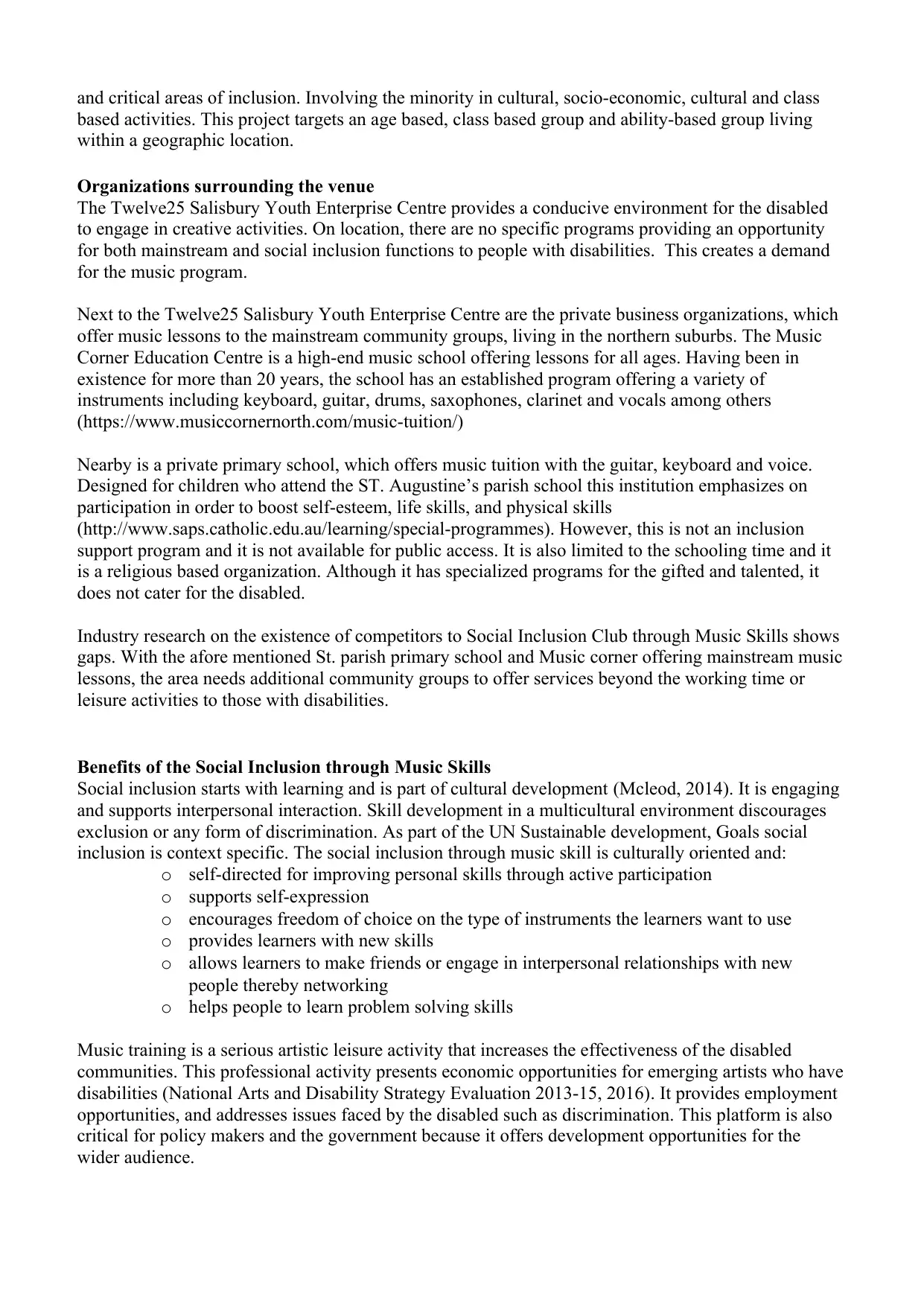
and critical areas of inclusion. Involving the minority in cultural, socio-economic, cultural and class
based activities. This project targets an age based, class based group and ability-based group living
within a geographic location.
Organizations surrounding the venue
The Twelve25 Salisbury Youth Enterprise Centre provides a conducive environment for the disabled
to engage in creative activities. On location, there are no specific programs providing an opportunity
for both mainstream and social inclusion functions to people with disabilities. This creates a demand
for the music program.
Next to the Twelve25 Salisbury Youth Enterprise Centre are the private business organizations, which
offer music lessons to the mainstream community groups, living in the northern suburbs. The Music
Corner Education Centre is a high-end music school offering lessons for all ages. Having been in
existence for more than 20 years, the school has an established program offering a variety of
instruments including keyboard, guitar, drums, saxophones, clarinet and vocals among others
(https://www.musiccornernorth.com/music-tuition/)
Nearby is a private primary school, which offers music tuition with the guitar, keyboard and voice.
Designed for children who attend the ST. Augustine’s parish school this institution emphasizes on
participation in order to boost self-esteem, life skills, and physical skills
(http://www.saps.catholic.edu.au/learning/special-programmes). However, this is not an inclusion
support program and it is not available for public access. It is also limited to the schooling time and it
is a religious based organization. Although it has specialized programs for the gifted and talented, it
does not cater for the disabled.
Industry research on the existence of competitors to Social Inclusion Club through Music Skills shows
gaps. With the afore mentioned St. parish primary school and Music corner offering mainstream music
lessons, the area needs additional community groups to offer services beyond the working time or
leisure activities to those with disabilities.
Benefits of the Social Inclusion through Music Skills
Social inclusion starts with learning and is part of cultural development (Mcleod, 2014). It is engaging
and supports interpersonal interaction. Skill development in a multicultural environment discourages
exclusion or any form of discrimination. As part of the UN Sustainable development, Goals social
inclusion is context specific. The social inclusion through music skill is culturally oriented and:
o self-directed for improving personal skills through active participation
o supports self-expression
o encourages freedom of choice on the type of instruments the learners want to use
o provides learners with new skills
o allows learners to make friends or engage in interpersonal relationships with new
people thereby networking
o helps people to learn problem solving skills
Music training is a serious artistic leisure activity that increases the effectiveness of the disabled
communities. This professional activity presents economic opportunities for emerging artists who have
disabilities (National Arts and Disability Strategy Evaluation 2013-15, 2016). It provides employment
opportunities, and addresses issues faced by the disabled such as discrimination. This platform is also
critical for policy makers and the government because it offers development opportunities for the
wider audience.
based activities. This project targets an age based, class based group and ability-based group living
within a geographic location.
Organizations surrounding the venue
The Twelve25 Salisbury Youth Enterprise Centre provides a conducive environment for the disabled
to engage in creative activities. On location, there are no specific programs providing an opportunity
for both mainstream and social inclusion functions to people with disabilities. This creates a demand
for the music program.
Next to the Twelve25 Salisbury Youth Enterprise Centre are the private business organizations, which
offer music lessons to the mainstream community groups, living in the northern suburbs. The Music
Corner Education Centre is a high-end music school offering lessons for all ages. Having been in
existence for more than 20 years, the school has an established program offering a variety of
instruments including keyboard, guitar, drums, saxophones, clarinet and vocals among others
(https://www.musiccornernorth.com/music-tuition/)
Nearby is a private primary school, which offers music tuition with the guitar, keyboard and voice.
Designed for children who attend the ST. Augustine’s parish school this institution emphasizes on
participation in order to boost self-esteem, life skills, and physical skills
(http://www.saps.catholic.edu.au/learning/special-programmes). However, this is not an inclusion
support program and it is not available for public access. It is also limited to the schooling time and it
is a religious based organization. Although it has specialized programs for the gifted and talented, it
does not cater for the disabled.
Industry research on the existence of competitors to Social Inclusion Club through Music Skills shows
gaps. With the afore mentioned St. parish primary school and Music corner offering mainstream music
lessons, the area needs additional community groups to offer services beyond the working time or
leisure activities to those with disabilities.
Benefits of the Social Inclusion through Music Skills
Social inclusion starts with learning and is part of cultural development (Mcleod, 2014). It is engaging
and supports interpersonal interaction. Skill development in a multicultural environment discourages
exclusion or any form of discrimination. As part of the UN Sustainable development, Goals social
inclusion is context specific. The social inclusion through music skill is culturally oriented and:
o self-directed for improving personal skills through active participation
o supports self-expression
o encourages freedom of choice on the type of instruments the learners want to use
o provides learners with new skills
o allows learners to make friends or engage in interpersonal relationships with new
people thereby networking
o helps people to learn problem solving skills
Music training is a serious artistic leisure activity that increases the effectiveness of the disabled
communities. This professional activity presents economic opportunities for emerging artists who have
disabilities (National Arts and Disability Strategy Evaluation 2013-15, 2016). It provides employment
opportunities, and addresses issues faced by the disabled such as discrimination. This platform is also
critical for policy makers and the government because it offers development opportunities for the
wider audience.
Paraphrase This Document
Need a fresh take? Get an instant paraphrase of this document with our AI Paraphraser
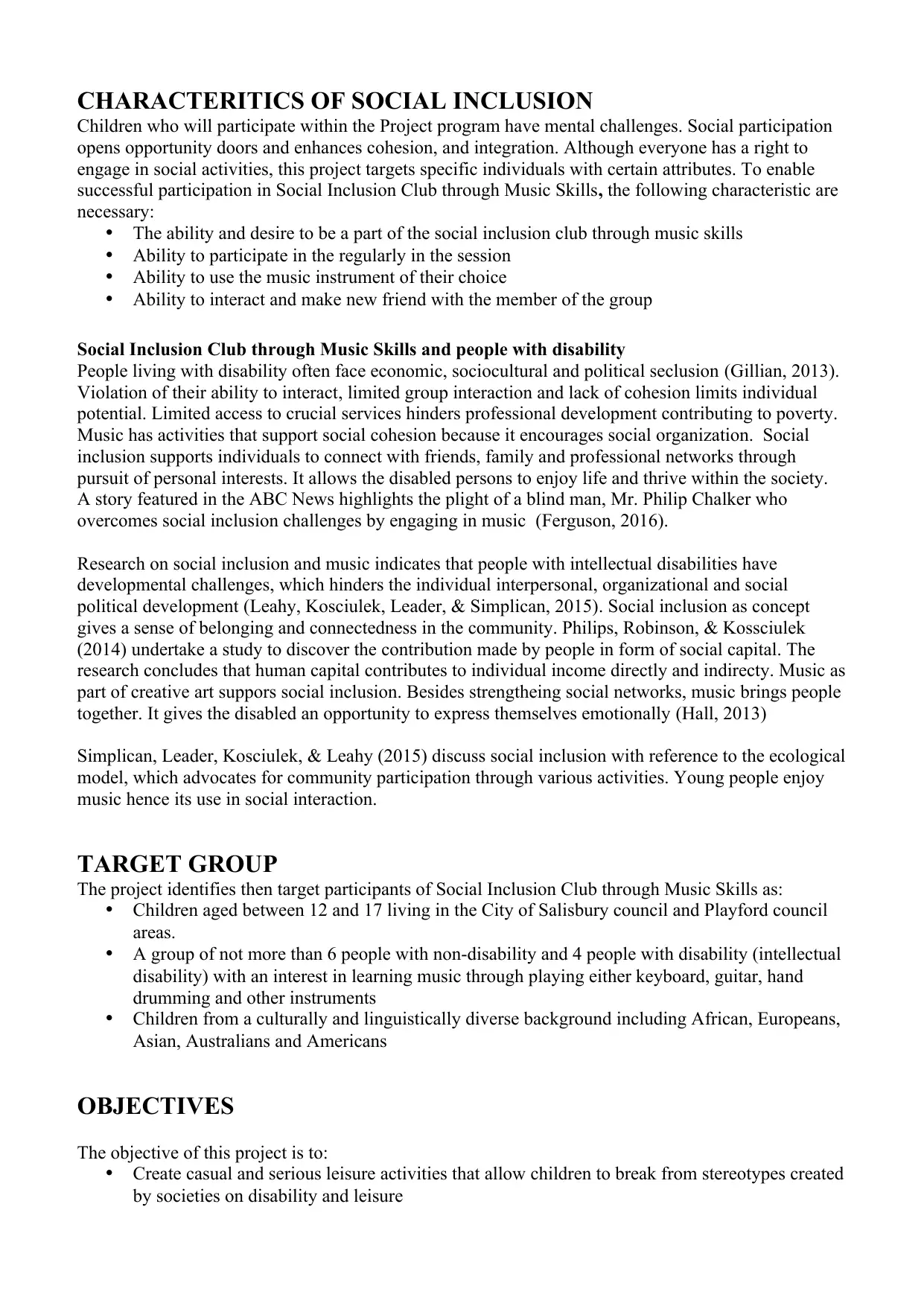
CHARACTERITICS OF SOCIAL INCLUSION
Children who will participate within the Project program have mental challenges. Social participation
opens opportunity doors and enhances cohesion, and integration. Although everyone has a right to
engage in social activities, this project targets specific individuals with certain attributes. To enable
successful participation in Social Inclusion Club through Music Skills, the following characteristic are
necessary:
The ability and desire to be a part of the social inclusion club through music skills
Ability to participate in the regularly in the session
Ability to use the music instrument of their choice
Ability to interact and make new friend with the member of the group
Social Inclusion Club through Music Skills and people with disability
People living with disability often face economic, sociocultural and political seclusion (Gillian, 2013).
Violation of their ability to interact, limited group interaction and lack of cohesion limits individual
potential. Limited access to crucial services hinders professional development contributing to poverty.
Music has activities that support social cohesion because it encourages social organization. Social
inclusion supports individuals to connect with friends, family and professional networks through
pursuit of personal interests. It allows the disabled persons to enjoy life and thrive within the society.
A story featured in the ABC News highlights the plight of a blind man, Mr. Philip Chalker who
overcomes social inclusion challenges by engaging in music (Ferguson, 2016).
Research on social inclusion and music indicates that people with intellectual disabilities have
developmental challenges, which hinders the individual interpersonal, organizational and social
political development (Leahy, Kosciulek, Leader, & Simplican, 2015). Social inclusion as concept
gives a sense of belonging and connectedness in the community. Philips, Robinson, & Kossciulek
(2014) undertake a study to discover the contribution made by people in form of social capital. The
research concludes that human capital contributes to individual income directly and indirecty. Music as
part of creative art suppors social inclusion. Besides strengtheing social networks, music brings people
together. It gives the disabled an opportunity to express themselves emotionally (Hall, 2013)
Simplican, Leader, Kosciulek, & Leahy (2015) discuss social inclusion with reference to the ecological
model, which advocates for community participation through various activities. Young people enjoy
music hence its use in social interaction.
TARGET GROUP
The project identifies then target participants of Social Inclusion Club through Music Skills as:
Children aged between 12 and 17 living in the City of Salisbury council and Playford council
areas.
A group of not more than 6 people with non-disability and 4 people with disability (intellectual
disability) with an interest in learning music through playing either keyboard, guitar, hand
drumming and other instruments
Children from a culturally and linguistically diverse background including African, Europeans,
Asian, Australians and Americans
OBJECTIVES
The objective of this project is to:
Create casual and serious leisure activities that allow children to break from stereotypes created
by societies on disability and leisure
Children who will participate within the Project program have mental challenges. Social participation
opens opportunity doors and enhances cohesion, and integration. Although everyone has a right to
engage in social activities, this project targets specific individuals with certain attributes. To enable
successful participation in Social Inclusion Club through Music Skills, the following characteristic are
necessary:
The ability and desire to be a part of the social inclusion club through music skills
Ability to participate in the regularly in the session
Ability to use the music instrument of their choice
Ability to interact and make new friend with the member of the group
Social Inclusion Club through Music Skills and people with disability
People living with disability often face economic, sociocultural and political seclusion (Gillian, 2013).
Violation of their ability to interact, limited group interaction and lack of cohesion limits individual
potential. Limited access to crucial services hinders professional development contributing to poverty.
Music has activities that support social cohesion because it encourages social organization. Social
inclusion supports individuals to connect with friends, family and professional networks through
pursuit of personal interests. It allows the disabled persons to enjoy life and thrive within the society.
A story featured in the ABC News highlights the plight of a blind man, Mr. Philip Chalker who
overcomes social inclusion challenges by engaging in music (Ferguson, 2016).
Research on social inclusion and music indicates that people with intellectual disabilities have
developmental challenges, which hinders the individual interpersonal, organizational and social
political development (Leahy, Kosciulek, Leader, & Simplican, 2015). Social inclusion as concept
gives a sense of belonging and connectedness in the community. Philips, Robinson, & Kossciulek
(2014) undertake a study to discover the contribution made by people in form of social capital. The
research concludes that human capital contributes to individual income directly and indirecty. Music as
part of creative art suppors social inclusion. Besides strengtheing social networks, music brings people
together. It gives the disabled an opportunity to express themselves emotionally (Hall, 2013)
Simplican, Leader, Kosciulek, & Leahy (2015) discuss social inclusion with reference to the ecological
model, which advocates for community participation through various activities. Young people enjoy
music hence its use in social interaction.
TARGET GROUP
The project identifies then target participants of Social Inclusion Club through Music Skills as:
Children aged between 12 and 17 living in the City of Salisbury council and Playford council
areas.
A group of not more than 6 people with non-disability and 4 people with disability (intellectual
disability) with an interest in learning music through playing either keyboard, guitar, hand
drumming and other instruments
Children from a culturally and linguistically diverse background including African, Europeans,
Asian, Australians and Americans
OBJECTIVES
The objective of this project is to:
Create casual and serious leisure activities that allow children to break from stereotypes created
by societies on disability and leisure
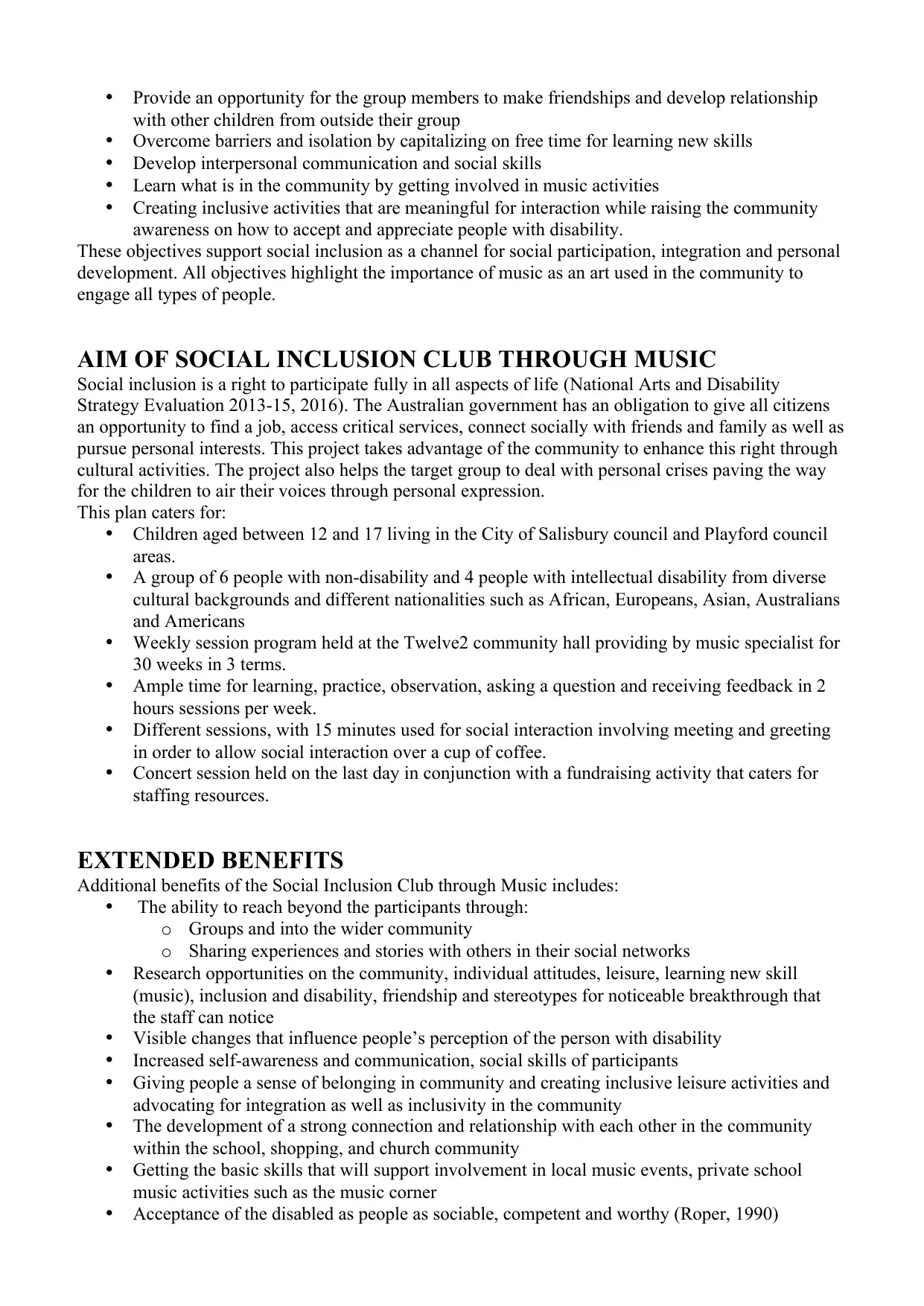
Provide an opportunity for the group members to make friendships and develop relationship
with other children from outside their group
Overcome barriers and isolation by capitalizing on free time for learning new skills
Develop interpersonal communication and social skills
Learn what is in the community by getting involved in music activities
Creating inclusive activities that are meaningful for interaction while raising the community
awareness on how to accept and appreciate people with disability.
These objectives support social inclusion as a channel for social participation, integration and personal
development. All objectives highlight the importance of music as an art used in the community to
engage all types of people.
AIM OF SOCIAL INCLUSION CLUB THROUGH MUSIC
Social inclusion is a right to participate fully in all aspects of life (National Arts and Disability
Strategy Evaluation 2013-15, 2016). The Australian government has an obligation to give all citizens
an opportunity to find a job, access critical services, connect socially with friends and family as well as
pursue personal interests. This project takes advantage of the community to enhance this right through
cultural activities. The project also helps the target group to deal with personal crises paving the way
for the children to air their voices through personal expression.
This plan caters for:
Children aged between 12 and 17 living in the City of Salisbury council and Playford council
areas.
A group of 6 people with non-disability and 4 people with intellectual disability from diverse
cultural backgrounds and different nationalities such as African, Europeans, Asian, Australians
and Americans
Weekly session program held at the Twelve2 community hall providing by music specialist for
30 weeks in 3 terms.
Ample time for learning, practice, observation, asking a question and receiving feedback in 2
hours sessions per week.
Different sessions, with 15 minutes used for social interaction involving meeting and greeting
in order to allow social interaction over a cup of coffee.
Concert session held on the last day in conjunction with a fundraising activity that caters for
staffing resources.
EXTENDED BENEFITS
Additional benefits of the Social Inclusion Club through Music includes:
The ability to reach beyond the participants through:
o Groups and into the wider community
o Sharing experiences and stories with others in their social networks
Research opportunities on the community, individual attitudes, leisure, learning new skill
(music), inclusion and disability, friendship and stereotypes for noticeable breakthrough that
the staff can notice
Visible changes that influence people’s perception of the person with disability
Increased self-awareness and communication, social skills of participants
Giving people a sense of belonging in community and creating inclusive leisure activities and
advocating for integration as well as inclusivity in the community
The development of a strong connection and relationship with each other in the community
within the school, shopping, and church community
Getting the basic skills that will support involvement in local music events, private school
music activities such as the music corner
Acceptance of the disabled as people as sociable, competent and worthy (Roper, 1990)
with other children from outside their group
Overcome barriers and isolation by capitalizing on free time for learning new skills
Develop interpersonal communication and social skills
Learn what is in the community by getting involved in music activities
Creating inclusive activities that are meaningful for interaction while raising the community
awareness on how to accept and appreciate people with disability.
These objectives support social inclusion as a channel for social participation, integration and personal
development. All objectives highlight the importance of music as an art used in the community to
engage all types of people.
AIM OF SOCIAL INCLUSION CLUB THROUGH MUSIC
Social inclusion is a right to participate fully in all aspects of life (National Arts and Disability
Strategy Evaluation 2013-15, 2016). The Australian government has an obligation to give all citizens
an opportunity to find a job, access critical services, connect socially with friends and family as well as
pursue personal interests. This project takes advantage of the community to enhance this right through
cultural activities. The project also helps the target group to deal with personal crises paving the way
for the children to air their voices through personal expression.
This plan caters for:
Children aged between 12 and 17 living in the City of Salisbury council and Playford council
areas.
A group of 6 people with non-disability and 4 people with intellectual disability from diverse
cultural backgrounds and different nationalities such as African, Europeans, Asian, Australians
and Americans
Weekly session program held at the Twelve2 community hall providing by music specialist for
30 weeks in 3 terms.
Ample time for learning, practice, observation, asking a question and receiving feedback in 2
hours sessions per week.
Different sessions, with 15 minutes used for social interaction involving meeting and greeting
in order to allow social interaction over a cup of coffee.
Concert session held on the last day in conjunction with a fundraising activity that caters for
staffing resources.
EXTENDED BENEFITS
Additional benefits of the Social Inclusion Club through Music includes:
The ability to reach beyond the participants through:
o Groups and into the wider community
o Sharing experiences and stories with others in their social networks
Research opportunities on the community, individual attitudes, leisure, learning new skill
(music), inclusion and disability, friendship and stereotypes for noticeable breakthrough that
the staff can notice
Visible changes that influence people’s perception of the person with disability
Increased self-awareness and communication, social skills of participants
Giving people a sense of belonging in community and creating inclusive leisure activities and
advocating for integration as well as inclusivity in the community
The development of a strong connection and relationship with each other in the community
within the school, shopping, and church community
Getting the basic skills that will support involvement in local music events, private school
music activities such as the music corner
Acceptance of the disabled as people as sociable, competent and worthy (Roper, 1990)
⊘ This is a preview!⊘
Do you want full access?
Subscribe today to unlock all pages.

Trusted by 1+ million students worldwide
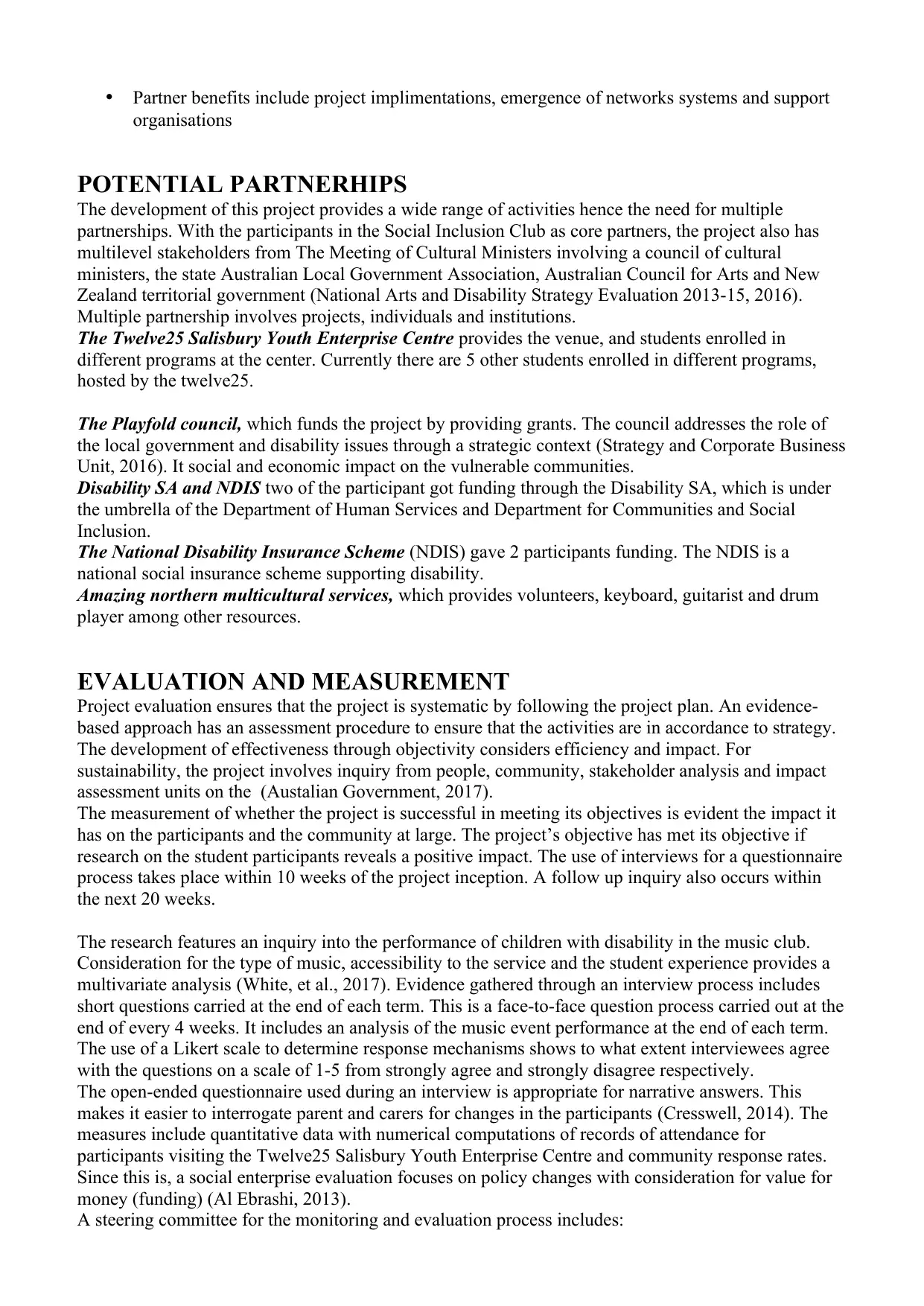
Partner benefits include project implimentations, emergence of networks systems and support
organisations
POTENTIAL PARTNERHIPS
The development of this project provides a wide range of activities hence the need for multiple
partnerships. With the participants in the Social Inclusion Club as core partners, the project also has
multilevel stakeholders from The Meeting of Cultural Ministers involving a council of cultural
ministers, the state Australian Local Government Association, Australian Council for Arts and New
Zealand territorial government (National Arts and Disability Strategy Evaluation 2013-15, 2016).
Multiple partnership involves projects, individuals and institutions.
The Twelve25 Salisbury Youth Enterprise Centre provides the venue, and students enrolled in
different programs at the center. Currently there are 5 other students enrolled in different programs,
hosted by the twelve25.
The Playfold council, which funds the project by providing grants. The council addresses the role of
the local government and disability issues through a strategic context (Strategy and Corporate Business
Unit, 2016). It social and economic impact on the vulnerable communities.
Disability SA and NDIS two of the participant got funding through the Disability SA, which is under
the umbrella of the Department of Human Services and Department for Communities and Social
Inclusion.
The National Disability Insurance Scheme (NDIS) gave 2 participants funding. The NDIS is a
national social insurance scheme supporting disability.
Amazing northern multicultural services, which provides volunteers, keyboard, guitarist and drum
player among other resources.
EVALUATION AND MEASUREMENT
Project evaluation ensures that the project is systematic by following the project plan. An evidence-
based approach has an assessment procedure to ensure that the activities are in accordance to strategy.
The development of effectiveness through objectivity considers efficiency and impact. For
sustainability, the project involves inquiry from people, community, stakeholder analysis and impact
assessment units on the (Austalian Government, 2017).
The measurement of whether the project is successful in meeting its objectives is evident the impact it
has on the participants and the community at large. The project’s objective has met its objective if
research on the student participants reveals a positive impact. The use of interviews for a questionnaire
process takes place within 10 weeks of the project inception. A follow up inquiry also occurs within
the next 20 weeks.
The research features an inquiry into the performance of children with disability in the music club.
Consideration for the type of music, accessibility to the service and the student experience provides a
multivariate analysis (White, et al., 2017). Evidence gathered through an interview process includes
short questions carried at the end of each term. This is a face-to-face question process carried out at the
end of every 4 weeks. It includes an analysis of the music event performance at the end of each term.
The use of a Likert scale to determine response mechanisms shows to what extent interviewees agree
with the questions on a scale of 1-5 from strongly agree and strongly disagree respectively.
The open-ended questionnaire used during an interview is appropriate for narrative answers. This
makes it easier to interrogate parent and carers for changes in the participants (Cresswell, 2014). The
measures include quantitative data with numerical computations of records of attendance for
participants visiting the Twelve25 Salisbury Youth Enterprise Centre and community response rates.
Since this is, a social enterprise evaluation focuses on policy changes with consideration for value for
money (funding) (Al Ebrashi, 2013).
A steering committee for the monitoring and evaluation process includes:
organisations
POTENTIAL PARTNERHIPS
The development of this project provides a wide range of activities hence the need for multiple
partnerships. With the participants in the Social Inclusion Club as core partners, the project also has
multilevel stakeholders from The Meeting of Cultural Ministers involving a council of cultural
ministers, the state Australian Local Government Association, Australian Council for Arts and New
Zealand territorial government (National Arts and Disability Strategy Evaluation 2013-15, 2016).
Multiple partnership involves projects, individuals and institutions.
The Twelve25 Salisbury Youth Enterprise Centre provides the venue, and students enrolled in
different programs at the center. Currently there are 5 other students enrolled in different programs,
hosted by the twelve25.
The Playfold council, which funds the project by providing grants. The council addresses the role of
the local government and disability issues through a strategic context (Strategy and Corporate Business
Unit, 2016). It social and economic impact on the vulnerable communities.
Disability SA and NDIS two of the participant got funding through the Disability SA, which is under
the umbrella of the Department of Human Services and Department for Communities and Social
Inclusion.
The National Disability Insurance Scheme (NDIS) gave 2 participants funding. The NDIS is a
national social insurance scheme supporting disability.
Amazing northern multicultural services, which provides volunteers, keyboard, guitarist and drum
player among other resources.
EVALUATION AND MEASUREMENT
Project evaluation ensures that the project is systematic by following the project plan. An evidence-
based approach has an assessment procedure to ensure that the activities are in accordance to strategy.
The development of effectiveness through objectivity considers efficiency and impact. For
sustainability, the project involves inquiry from people, community, stakeholder analysis and impact
assessment units on the (Austalian Government, 2017).
The measurement of whether the project is successful in meeting its objectives is evident the impact it
has on the participants and the community at large. The project’s objective has met its objective if
research on the student participants reveals a positive impact. The use of interviews for a questionnaire
process takes place within 10 weeks of the project inception. A follow up inquiry also occurs within
the next 20 weeks.
The research features an inquiry into the performance of children with disability in the music club.
Consideration for the type of music, accessibility to the service and the student experience provides a
multivariate analysis (White, et al., 2017). Evidence gathered through an interview process includes
short questions carried at the end of each term. This is a face-to-face question process carried out at the
end of every 4 weeks. It includes an analysis of the music event performance at the end of each term.
The use of a Likert scale to determine response mechanisms shows to what extent interviewees agree
with the questions on a scale of 1-5 from strongly agree and strongly disagree respectively.
The open-ended questionnaire used during an interview is appropriate for narrative answers. This
makes it easier to interrogate parent and carers for changes in the participants (Cresswell, 2014). The
measures include quantitative data with numerical computations of records of attendance for
participants visiting the Twelve25 Salisbury Youth Enterprise Centre and community response rates.
Since this is, a social enterprise evaluation focuses on policy changes with consideration for value for
money (funding) (Al Ebrashi, 2013).
A steering committee for the monitoring and evaluation process includes:
Paraphrase This Document
Need a fresh take? Get an instant paraphrase of this document with our AI Paraphraser
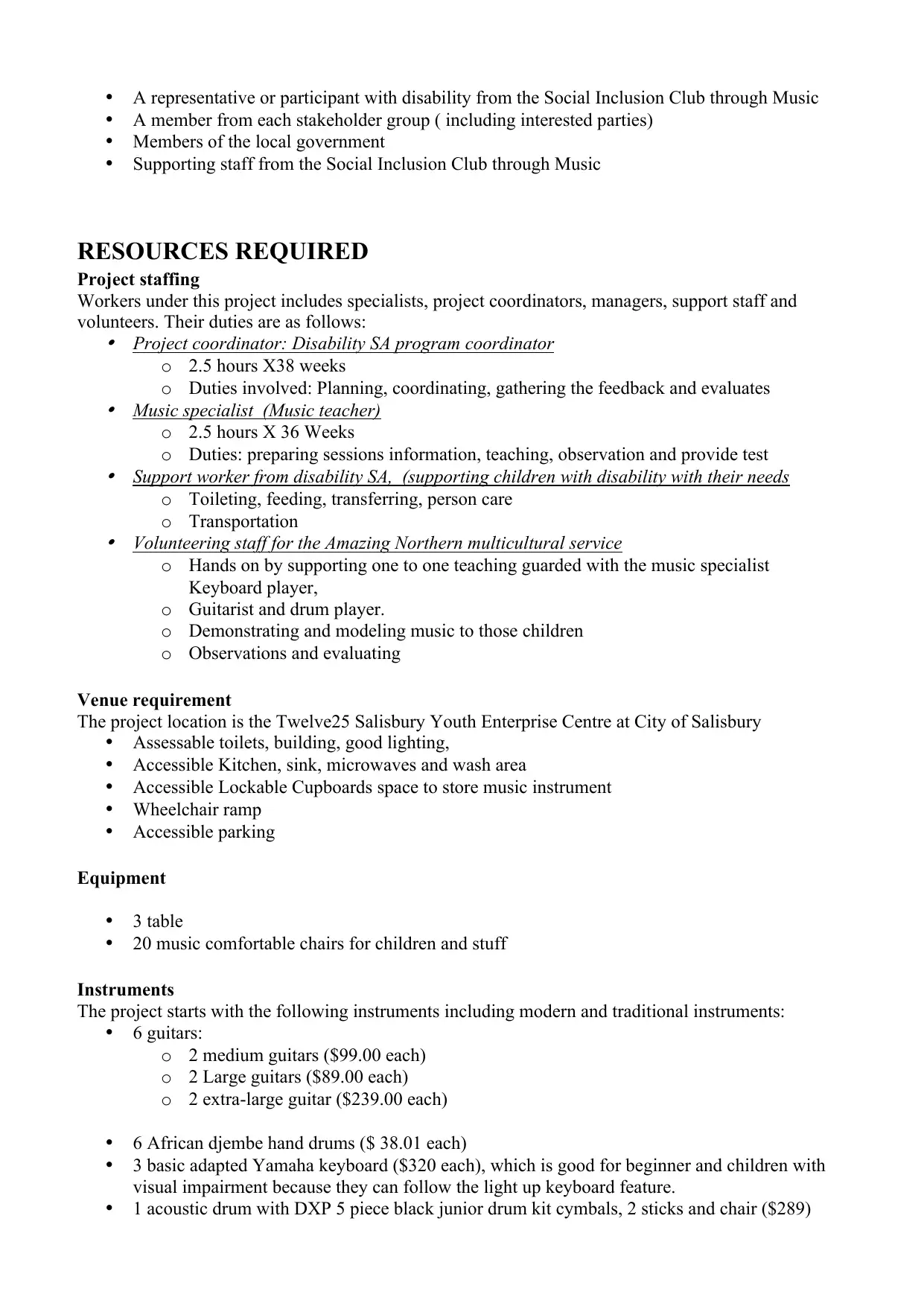
A representative or participant with disability from the Social Inclusion Club through Music
A member from each stakeholder group ( including interested parties)
Members of the local government
Supporting staff from the Social Inclusion Club through Music
RESOURCES REQUIRED
Project staffing
Workers under this project includes specialists, project coordinators, managers, support staff and
volunteers. Their duties are as follows:
Project coordinator: Disability SA program coordinator
o 2.5 hours X38 weeks
o Duties involved: Planning, coordinating, gathering the feedback and evaluates
Music specialist (Music teacher)
o 2.5 hours X 36 Weeks
o Duties: preparing sessions information, teaching, observation and provide test
Support worker from disability SA, (supporting children with disability with their needs
o Toileting, feeding, transferring, person care
o Transportation
Volunteering staff for the Amazing Northern multicultural service
o Hands on by supporting one to one teaching guarded with the music specialist
Keyboard player,
o Guitarist and drum player.
o Demonstrating and modeling music to those children
o Observations and evaluating
Venue requirement
The project location is the Twelve25 Salisbury Youth Enterprise Centre at City of Salisbury
Assessable toilets, building, good lighting,
Accessible Kitchen, sink, microwaves and wash area
Accessible Lockable Cupboards space to store music instrument
Wheelchair ramp
Accessible parking
Equipment
3 table
20 music comfortable chairs for children and stuff
Instruments
The project starts with the following instruments including modern and traditional instruments:
6 guitars:
o 2 medium guitars ($99.00 each)
o 2 Large guitars ($89.00 each)
o 2 extra-large guitar ($239.00 each)
6 African djembe hand drums ($ 38.01 each)
3 basic adapted Yamaha keyboard ($320 each), which is good for beginner and children with
visual impairment because they can follow the light up keyboard feature.
1 acoustic drum with DXP 5 piece black junior drum kit cymbals, 2 sticks and chair ($289)
A member from each stakeholder group ( including interested parties)
Members of the local government
Supporting staff from the Social Inclusion Club through Music
RESOURCES REQUIRED
Project staffing
Workers under this project includes specialists, project coordinators, managers, support staff and
volunteers. Their duties are as follows:
Project coordinator: Disability SA program coordinator
o 2.5 hours X38 weeks
o Duties involved: Planning, coordinating, gathering the feedback and evaluates
Music specialist (Music teacher)
o 2.5 hours X 36 Weeks
o Duties: preparing sessions information, teaching, observation and provide test
Support worker from disability SA, (supporting children with disability with their needs
o Toileting, feeding, transferring, person care
o Transportation
Volunteering staff for the Amazing Northern multicultural service
o Hands on by supporting one to one teaching guarded with the music specialist
Keyboard player,
o Guitarist and drum player.
o Demonstrating and modeling music to those children
o Observations and evaluating
Venue requirement
The project location is the Twelve25 Salisbury Youth Enterprise Centre at City of Salisbury
Assessable toilets, building, good lighting,
Accessible Kitchen, sink, microwaves and wash area
Accessible Lockable Cupboards space to store music instrument
Wheelchair ramp
Accessible parking
Equipment
3 table
20 music comfortable chairs for children and stuff
Instruments
The project starts with the following instruments including modern and traditional instruments:
6 guitars:
o 2 medium guitars ($99.00 each)
o 2 Large guitars ($89.00 each)
o 2 extra-large guitar ($239.00 each)
6 African djembe hand drums ($ 38.01 each)
3 basic adapted Yamaha keyboard ($320 each), which is good for beginner and children with
visual impairment because they can follow the light up keyboard feature.
1 acoustic drum with DXP 5 piece black junior drum kit cymbals, 2 sticks and chair ($289)
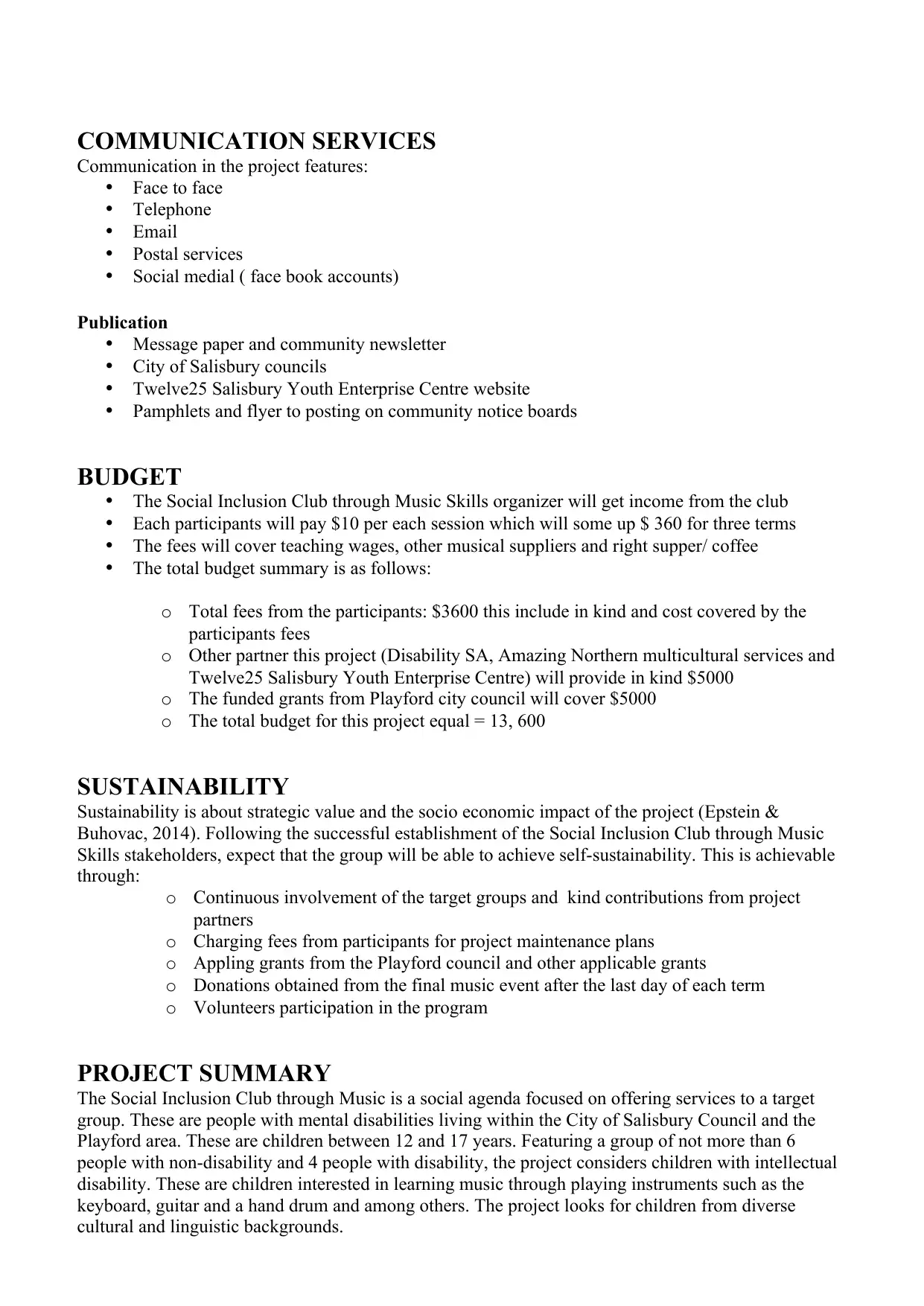
COMMUNICATION SERVICES
Communication in the project features:
Face to face
Telephone
Email
Postal services
Social medial ( face book accounts)
Publication
Message paper and community newsletter
City of Salisbury councils
Twelve25 Salisbury Youth Enterprise Centre website
Pamphlets and flyer to posting on community notice boards
BUDGET
The Social Inclusion Club through Music Skills organizer will get income from the club
Each participants will pay $10 per each session which will some up $ 360 for three terms
The fees will cover teaching wages, other musical suppliers and right supper/ coffee
The total budget summary is as follows:
o Total fees from the participants: $3600 this include in kind and cost covered by the
participants fees
o Other partner this project (Disability SA, Amazing Northern multicultural services and
Twelve25 Salisbury Youth Enterprise Centre) will provide in kind $5000
o The funded grants from Playford city council will cover $5000
o The total budget for this project equal = 13, 600
SUSTAINABILITY
Sustainability is about strategic value and the socio economic impact of the project (Epstein &
Buhovac, 2014). Following the successful establishment of the Social Inclusion Club through Music
Skills stakeholders, expect that the group will be able to achieve self-sustainability. This is achievable
through:
o Continuous involvement of the target groups and kind contributions from project
partners
o Charging fees from participants for project maintenance plans
o Appling grants from the Playford council and other applicable grants
o Donations obtained from the final music event after the last day of each term
o Volunteers participation in the program
PROJECT SUMMARY
The Social Inclusion Club through Music is a social agenda focused on offering services to a target
group. These are people with mental disabilities living within the City of Salisbury Council and the
Playford area. These are children between 12 and 17 years. Featuring a group of not more than 6
people with non-disability and 4 people with disability, the project considers children with intellectual
disability. These are children interested in learning music through playing instruments such as the
keyboard, guitar and a hand drum and among others. The project looks for children from diverse
cultural and linguistic backgrounds.
Communication in the project features:
Face to face
Telephone
Postal services
Social medial ( face book accounts)
Publication
Message paper and community newsletter
City of Salisbury councils
Twelve25 Salisbury Youth Enterprise Centre website
Pamphlets and flyer to posting on community notice boards
BUDGET
The Social Inclusion Club through Music Skills organizer will get income from the club
Each participants will pay $10 per each session which will some up $ 360 for three terms
The fees will cover teaching wages, other musical suppliers and right supper/ coffee
The total budget summary is as follows:
o Total fees from the participants: $3600 this include in kind and cost covered by the
participants fees
o Other partner this project (Disability SA, Amazing Northern multicultural services and
Twelve25 Salisbury Youth Enterprise Centre) will provide in kind $5000
o The funded grants from Playford city council will cover $5000
o The total budget for this project equal = 13, 600
SUSTAINABILITY
Sustainability is about strategic value and the socio economic impact of the project (Epstein &
Buhovac, 2014). Following the successful establishment of the Social Inclusion Club through Music
Skills stakeholders, expect that the group will be able to achieve self-sustainability. This is achievable
through:
o Continuous involvement of the target groups and kind contributions from project
partners
o Charging fees from participants for project maintenance plans
o Appling grants from the Playford council and other applicable grants
o Donations obtained from the final music event after the last day of each term
o Volunteers participation in the program
PROJECT SUMMARY
The Social Inclusion Club through Music is a social agenda focused on offering services to a target
group. These are people with mental disabilities living within the City of Salisbury Council and the
Playford area. These are children between 12 and 17 years. Featuring a group of not more than 6
people with non-disability and 4 people with disability, the project considers children with intellectual
disability. These are children interested in learning music through playing instruments such as the
keyboard, guitar and a hand drum and among others. The project looks for children from diverse
cultural and linguistic backgrounds.
⊘ This is a preview!⊘
Do you want full access?
Subscribe today to unlock all pages.

Trusted by 1+ million students worldwide
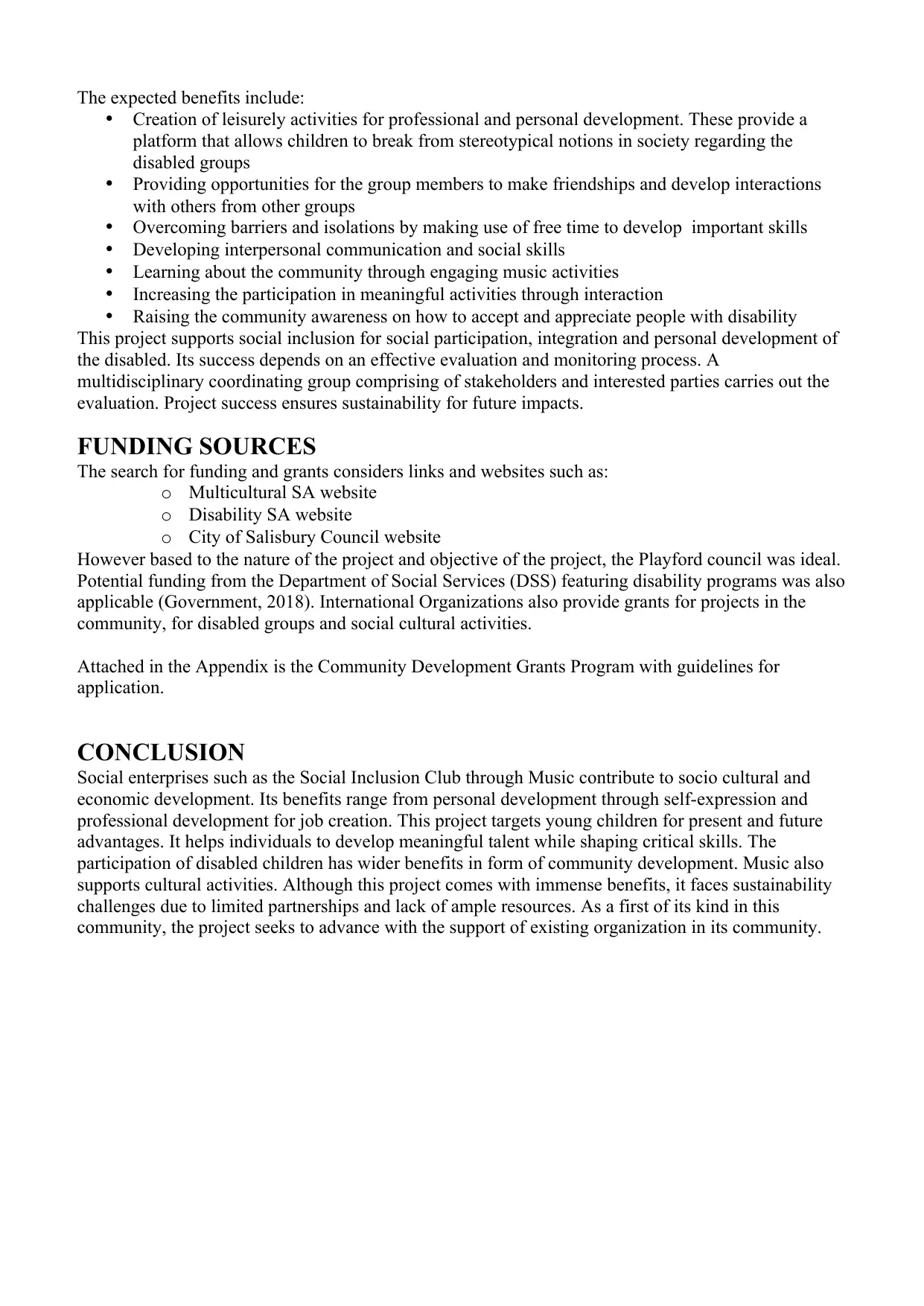
The expected benefits include:
Creation of leisurely activities for professional and personal development. These provide a
platform that allows children to break from stereotypical notions in society regarding the
disabled groups
Providing opportunities for the group members to make friendships and develop interactions
with others from other groups
Overcoming barriers and isolations by making use of free time to develop important skills
Developing interpersonal communication and social skills
Learning about the community through engaging music activities
Increasing the participation in meaningful activities through interaction
Raising the community awareness on how to accept and appreciate people with disability
This project supports social inclusion for social participation, integration and personal development of
the disabled. Its success depends on an effective evaluation and monitoring process. A
multidisciplinary coordinating group comprising of stakeholders and interested parties carries out the
evaluation. Project success ensures sustainability for future impacts.
FUNDING SOURCES
The search for funding and grants considers links and websites such as:
o Multicultural SA website
o Disability SA website
o City of Salisbury Council website
However based to the nature of the project and objective of the project, the Playford council was ideal.
Potential funding from the Department of Social Services (DSS) featuring disability programs was also
applicable (Government, 2018). International Organizations also provide grants for projects in the
community, for disabled groups and social cultural activities.
Attached in the Appendix is the Community Development Grants Program with guidelines for
application.
CONCLUSION
Social enterprises such as the Social Inclusion Club through Music contribute to socio cultural and
economic development. Its benefits range from personal development through self-expression and
professional development for job creation. This project targets young children for present and future
advantages. It helps individuals to develop meaningful talent while shaping critical skills. The
participation of disabled children has wider benefits in form of community development. Music also
supports cultural activities. Although this project comes with immense benefits, it faces sustainability
challenges due to limited partnerships and lack of ample resources. As a first of its kind in this
community, the project seeks to advance with the support of existing organization in its community.
Creation of leisurely activities for professional and personal development. These provide a
platform that allows children to break from stereotypical notions in society regarding the
disabled groups
Providing opportunities for the group members to make friendships and develop interactions
with others from other groups
Overcoming barriers and isolations by making use of free time to develop important skills
Developing interpersonal communication and social skills
Learning about the community through engaging music activities
Increasing the participation in meaningful activities through interaction
Raising the community awareness on how to accept and appreciate people with disability
This project supports social inclusion for social participation, integration and personal development of
the disabled. Its success depends on an effective evaluation and monitoring process. A
multidisciplinary coordinating group comprising of stakeholders and interested parties carries out the
evaluation. Project success ensures sustainability for future impacts.
FUNDING SOURCES
The search for funding and grants considers links and websites such as:
o Multicultural SA website
o Disability SA website
o City of Salisbury Council website
However based to the nature of the project and objective of the project, the Playford council was ideal.
Potential funding from the Department of Social Services (DSS) featuring disability programs was also
applicable (Government, 2018). International Organizations also provide grants for projects in the
community, for disabled groups and social cultural activities.
Attached in the Appendix is the Community Development Grants Program with guidelines for
application.
CONCLUSION
Social enterprises such as the Social Inclusion Club through Music contribute to socio cultural and
economic development. Its benefits range from personal development through self-expression and
professional development for job creation. This project targets young children for present and future
advantages. It helps individuals to develop meaningful talent while shaping critical skills. The
participation of disabled children has wider benefits in form of community development. Music also
supports cultural activities. Although this project comes with immense benefits, it faces sustainability
challenges due to limited partnerships and lack of ample resources. As a first of its kind in this
community, the project seeks to advance with the support of existing organization in its community.
Paraphrase This Document
Need a fresh take? Get an instant paraphrase of this document with our AI Paraphraser
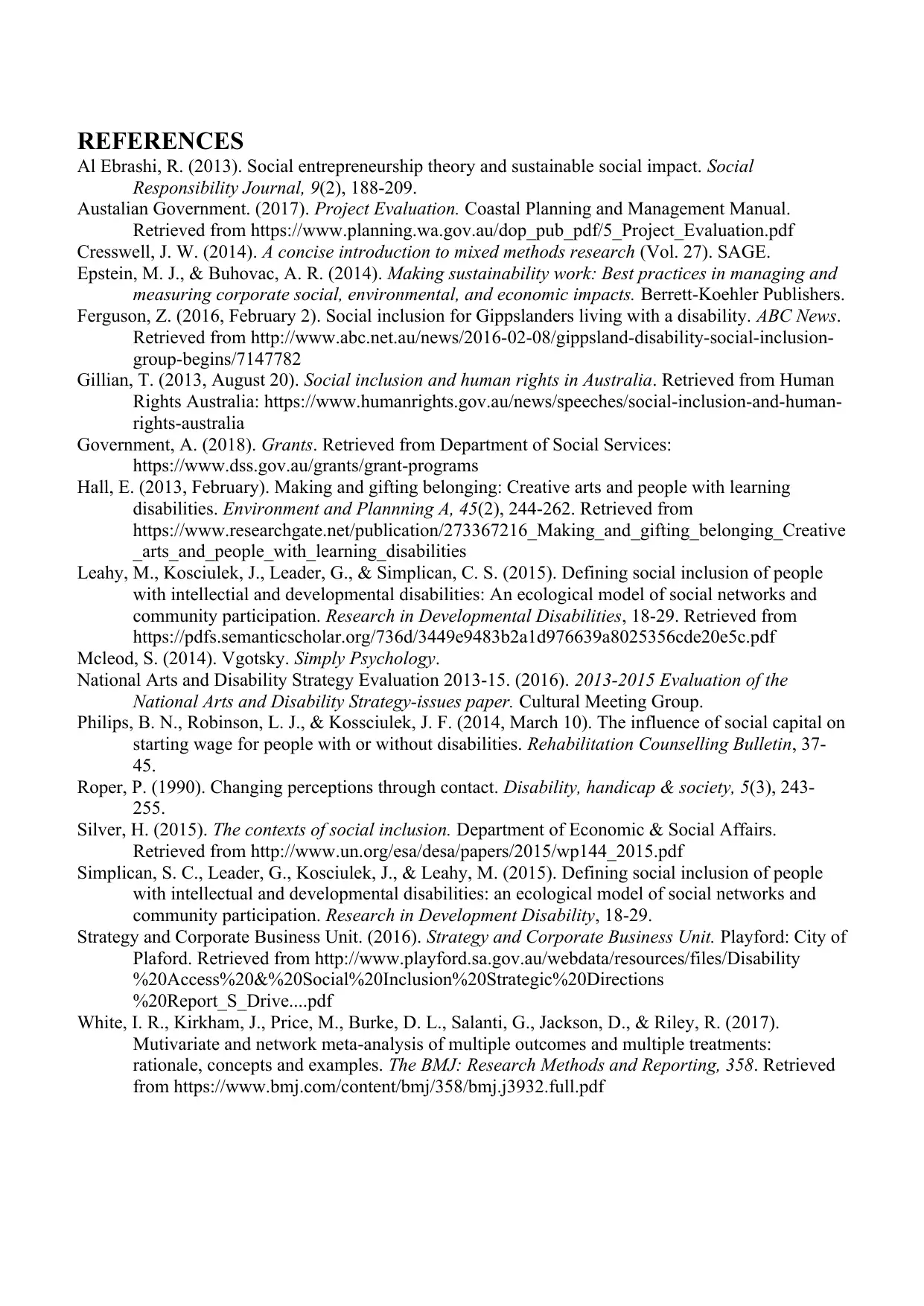
REFERENCES
Al Ebrashi, R. (2013). Social entrepreneurship theory and sustainable social impact. Social
Responsibility Journal, 9(2), 188-209.
Austalian Government. (2017). Project Evaluation. Coastal Planning and Management Manual.
Retrieved from https://www.planning.wa.gov.au/dop_pub_pdf/5_Project_Evaluation.pdf
Cresswell, J. W. (2014). A concise introduction to mixed methods research (Vol. 27). SAGE.
Epstein, M. J., & Buhovac, A. R. (2014). Making sustainability work: Best practices in managing and
measuring corporate social, environmental, and economic impacts. Berrett-Koehler Publishers.
Ferguson, Z. (2016, February 2). Social inclusion for Gippslanders living with a disability. ABC News.
Retrieved from http://www.abc.net.au/news/2016-02-08/gippsland-disability-social-inclusion-
group-begins/7147782
Gillian, T. (2013, August 20). Social inclusion and human rights in Australia. Retrieved from Human
Rights Australia: https://www.humanrights.gov.au/news/speeches/social-inclusion-and-human-
rights-australia
Government, A. (2018). Grants. Retrieved from Department of Social Services:
https://www.dss.gov.au/grants/grant-programs
Hall, E. (2013, February). Making and gifting belonging: Creative arts and people with learning
disabilities. Environment and Plannning A, 45(2), 244-262. Retrieved from
https://www.researchgate.net/publication/273367216_Making_and_gifting_belonging_Creative
_arts_and_people_with_learning_disabilities
Leahy, M., Kosciulek, J., Leader, G., & Simplican, C. S. (2015). Defining social inclusion of people
with intellectial and developmental disabilities: An ecological model of social networks and
community participation. Research in Developmental Disabilities, 18-29. Retrieved from
https://pdfs.semanticscholar.org/736d/3449e9483b2a1d976639a8025356cde20e5c.pdf
Mcleod, S. (2014). Vgotsky. Simply Psychology.
National Arts and Disability Strategy Evaluation 2013-15. (2016). 2013-2015 Evaluation of the
National Arts and Disability Strategy-issues paper. Cultural Meeting Group.
Philips, B. N., Robinson, L. J., & Kossciulek, J. F. (2014, March 10). The influence of social capital on
starting wage for people with or without disabilities. Rehabilitation Counselling Bulletin, 37-
45.
Roper, P. (1990). Changing perceptions through contact. Disability, handicap & society, 5(3), 243-
255.
Silver, H. (2015). The contexts of social inclusion. Department of Economic & Social Affairs.
Retrieved from http://www.un.org/esa/desa/papers/2015/wp144_2015.pdf
Simplican, S. C., Leader, G., Kosciulek, J., & Leahy, M. (2015). Defining social inclusion of people
with intellectual and developmental disabilities: an ecological model of social networks and
community participation. Research in Development Disability, 18-29.
Strategy and Corporate Business Unit. (2016). Strategy and Corporate Business Unit. Playford: City of
Plaford. Retrieved from http://www.playford.sa.gov.au/webdata/resources/files/Disability
%20Access%20&%20Social%20Inclusion%20Strategic%20Directions
%20Report_S_Drive....pdf
White, I. R., Kirkham, J., Price, M., Burke, D. L., Salanti, G., Jackson, D., & Riley, R. (2017).
Mutivariate and network meta-analysis of multiple outcomes and multiple treatments:
rationale, concepts and examples. The BMJ: Research Methods and Reporting, 358. Retrieved
from https://www.bmj.com/content/bmj/358/bmj.j3932.full.pdf
Al Ebrashi, R. (2013). Social entrepreneurship theory and sustainable social impact. Social
Responsibility Journal, 9(2), 188-209.
Austalian Government. (2017). Project Evaluation. Coastal Planning and Management Manual.
Retrieved from https://www.planning.wa.gov.au/dop_pub_pdf/5_Project_Evaluation.pdf
Cresswell, J. W. (2014). A concise introduction to mixed methods research (Vol. 27). SAGE.
Epstein, M. J., & Buhovac, A. R. (2014). Making sustainability work: Best practices in managing and
measuring corporate social, environmental, and economic impacts. Berrett-Koehler Publishers.
Ferguson, Z. (2016, February 2). Social inclusion for Gippslanders living with a disability. ABC News.
Retrieved from http://www.abc.net.au/news/2016-02-08/gippsland-disability-social-inclusion-
group-begins/7147782
Gillian, T. (2013, August 20). Social inclusion and human rights in Australia. Retrieved from Human
Rights Australia: https://www.humanrights.gov.au/news/speeches/social-inclusion-and-human-
rights-australia
Government, A. (2018). Grants. Retrieved from Department of Social Services:
https://www.dss.gov.au/grants/grant-programs
Hall, E. (2013, February). Making and gifting belonging: Creative arts and people with learning
disabilities. Environment and Plannning A, 45(2), 244-262. Retrieved from
https://www.researchgate.net/publication/273367216_Making_and_gifting_belonging_Creative
_arts_and_people_with_learning_disabilities
Leahy, M., Kosciulek, J., Leader, G., & Simplican, C. S. (2015). Defining social inclusion of people
with intellectial and developmental disabilities: An ecological model of social networks and
community participation. Research in Developmental Disabilities, 18-29. Retrieved from
https://pdfs.semanticscholar.org/736d/3449e9483b2a1d976639a8025356cde20e5c.pdf
Mcleod, S. (2014). Vgotsky. Simply Psychology.
National Arts and Disability Strategy Evaluation 2013-15. (2016). 2013-2015 Evaluation of the
National Arts and Disability Strategy-issues paper. Cultural Meeting Group.
Philips, B. N., Robinson, L. J., & Kossciulek, J. F. (2014, March 10). The influence of social capital on
starting wage for people with or without disabilities. Rehabilitation Counselling Bulletin, 37-
45.
Roper, P. (1990). Changing perceptions through contact. Disability, handicap & society, 5(3), 243-
255.
Silver, H. (2015). The contexts of social inclusion. Department of Economic & Social Affairs.
Retrieved from http://www.un.org/esa/desa/papers/2015/wp144_2015.pdf
Simplican, S. C., Leader, G., Kosciulek, J., & Leahy, M. (2015). Defining social inclusion of people
with intellectual and developmental disabilities: an ecological model of social networks and
community participation. Research in Development Disability, 18-29.
Strategy and Corporate Business Unit. (2016). Strategy and Corporate Business Unit. Playford: City of
Plaford. Retrieved from http://www.playford.sa.gov.au/webdata/resources/files/Disability
%20Access%20&%20Social%20Inclusion%20Strategic%20Directions
%20Report_S_Drive....pdf
White, I. R., Kirkham, J., Price, M., Burke, D. L., Salanti, G., Jackson, D., & Riley, R. (2017).
Mutivariate and network meta-analysis of multiple outcomes and multiple treatments:
rationale, concepts and examples. The BMJ: Research Methods and Reporting, 358. Retrieved
from https://www.bmj.com/content/bmj/358/bmj.j3932.full.pdf
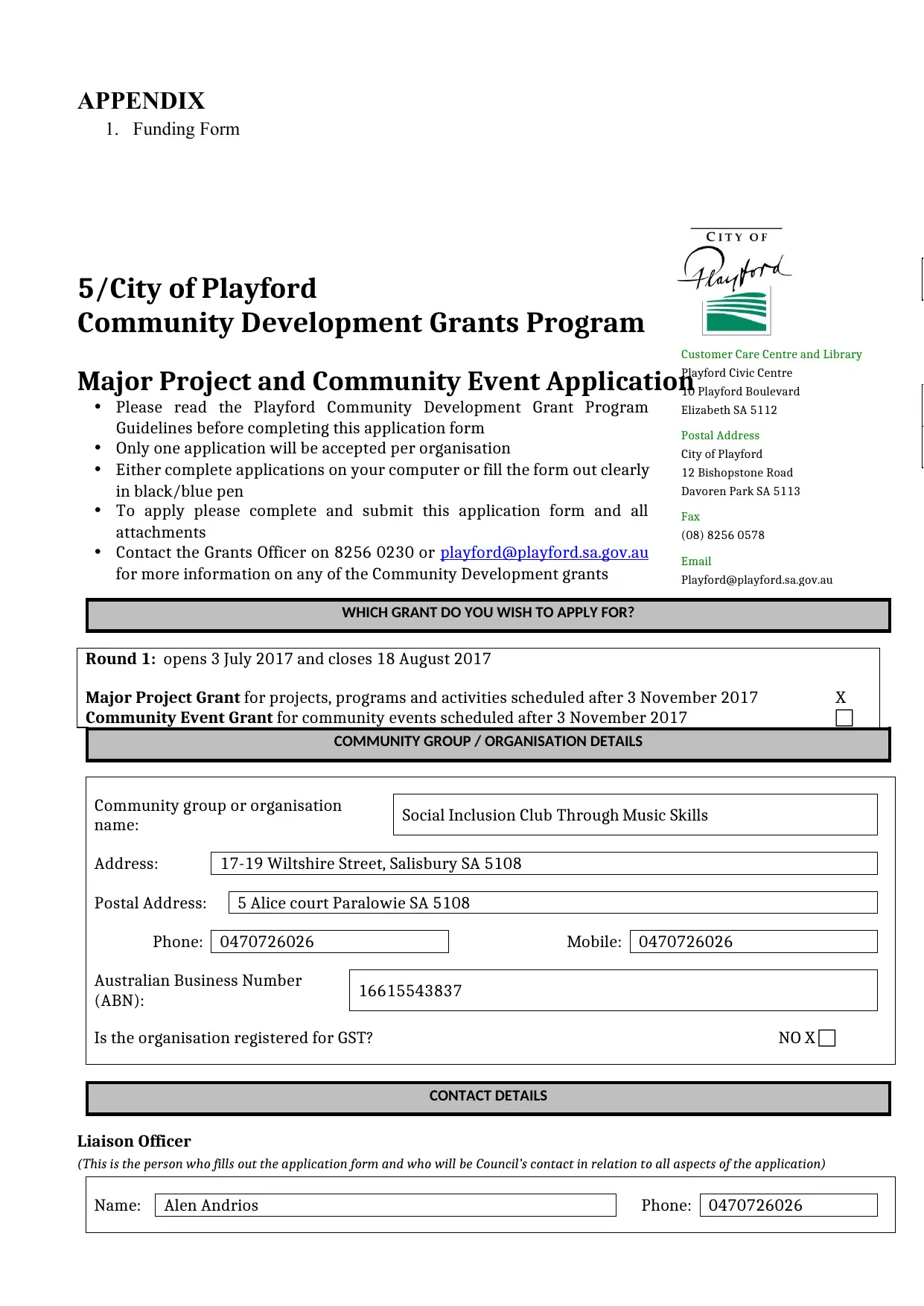
APPENDIX
1. Funding Form
5/City of Playford
Community Development Grants Program
Major Project and Community Event Application
Please read the Playford Community Development Grant Program
Guidelines before completing this application form
Only one application will be accepted per organisation
Either complete applications on your computer or fill the form out clearly
in black/blue pen
To apply please complete and submit this application form and all
attachments
Contact the Grants Officer on 8256 0230 or playford@playford.sa.gov.au
for more information on any of the Community Development grants
WHICH GRANT DO YOU WISH TO APPLY FOR?
Round 1: opens 3 July 2017 and closes 18 August 2017
Major Project Grant for projects, programs and activities scheduled after 3 November 2017 X
Community Event Grant for community events scheduled after 3 November 2017
COMMUNITY GROUP / ORGANISATION DETAILS
Community group or organisation
name: Social Inclusion Club Through Music Skills
Address: 17-19 Wiltshire Street, Salisbury SA 5108
Postal Address: 5 Alice court Paralowie SA 5108
Phone: 0470726026 Mobile: 0470726026
Australian Business Number
(ABN): 16615543837
Is the organisation registered for GST? NO X
CONTACT DETAILS
Liaison Officer
(This is the person who fills out the application form and who will be Council’s contact in relation to all aspects of the application)
Name: Alen Andrios Phone: 0470726026
Customer Care Centre and Library
Playford Civic Centre
10 Playford Boulevard
Elizabeth SA 5112
Postal Address
City of Playford
12 Bishopstone Road
Davoren Park SA 5113
Fax
(08) 8256 0578
Email
Playford@playford.sa.gov.au
1. Funding Form
5/City of Playford
Community Development Grants Program
Major Project and Community Event Application
Please read the Playford Community Development Grant Program
Guidelines before completing this application form
Only one application will be accepted per organisation
Either complete applications on your computer or fill the form out clearly
in black/blue pen
To apply please complete and submit this application form and all
attachments
Contact the Grants Officer on 8256 0230 or playford@playford.sa.gov.au
for more information on any of the Community Development grants
WHICH GRANT DO YOU WISH TO APPLY FOR?
Round 1: opens 3 July 2017 and closes 18 August 2017
Major Project Grant for projects, programs and activities scheduled after 3 November 2017 X
Community Event Grant for community events scheduled after 3 November 2017
COMMUNITY GROUP / ORGANISATION DETAILS
Community group or organisation
name: Social Inclusion Club Through Music Skills
Address: 17-19 Wiltshire Street, Salisbury SA 5108
Postal Address: 5 Alice court Paralowie SA 5108
Phone: 0470726026 Mobile: 0470726026
Australian Business Number
(ABN): 16615543837
Is the organisation registered for GST? NO X
CONTACT DETAILS
Liaison Officer
(This is the person who fills out the application form and who will be Council’s contact in relation to all aspects of the application)
Name: Alen Andrios Phone: 0470726026
Customer Care Centre and Library
Playford Civic Centre
10 Playford Boulevard
Elizabeth SA 5112
Postal Address
City of Playford
12 Bishopstone Road
Davoren Park SA 5113
Fax
(08) 8256 0578
Playford@playford.sa.gov.au
⊘ This is a preview!⊘
Do you want full access?
Subscribe today to unlock all pages.

Trusted by 1+ million students worldwide
1 out of 22
Related Documents
Your All-in-One AI-Powered Toolkit for Academic Success.
+13062052269
info@desklib.com
Available 24*7 on WhatsApp / Email
![[object Object]](/_next/static/media/star-bottom.7253800d.svg)
Unlock your academic potential
Copyright © 2020–2025 A2Z Services. All Rights Reserved. Developed and managed by ZUCOL.





